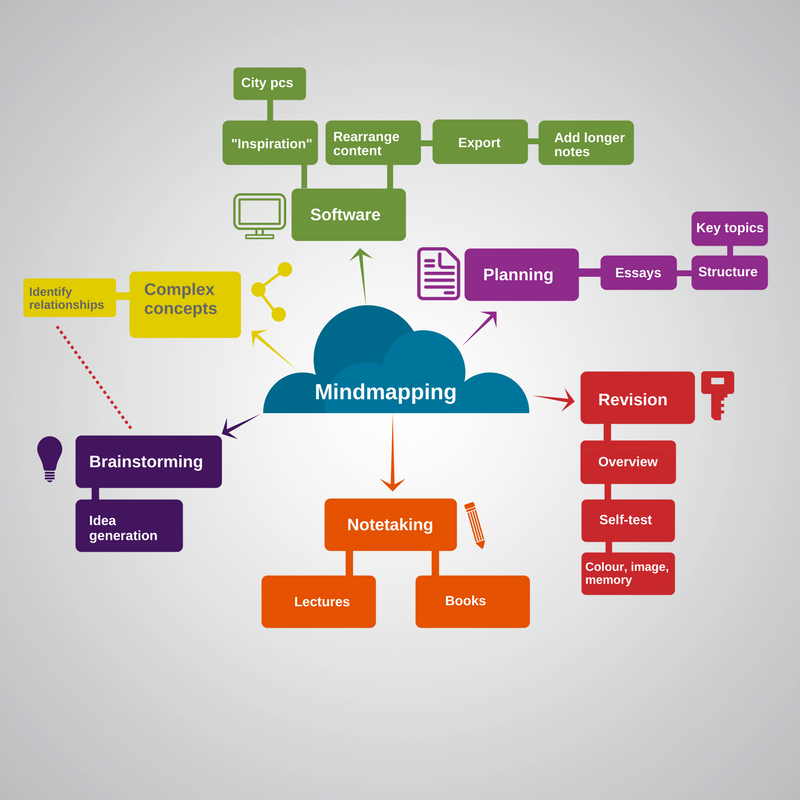Mind mapping is an active and visual way of representing information. Unlike linear notes (traditional notes written out), with a mind map you can view all of your notes on one page and visually identify structure and relationships more effectively.
You can use old fashioned paper and pencils or mind mapping software to create one. Just add your main idea or goal to the centre, then, using keywords add your main topics, and then your sub topics to those and so on.
6 ways mind mapping can support your studies
- Planning: You can use mind maps to help plan a project, essay or assignment. Creating a mind map can help you get all your ideas down, hone the structure, and generate and develop new content. Some software allows you to export your map’s hierarchy to a Word document so you can flesh out the bare bones of the framework. (I made a mind map to plan out this article!)
- Revision: Create an overview of the subject area. Some software include a notes field for adding longer sections of text. You could use these to enter answers to main questions and test yourself. Mind maps are an active way of learning. They can be multi-sensory – associating colours, images and keywords with information could create a hook for memory recall. You could think about displaying completed maps on a wall so you look at them often.
- Notetaking: Make notes from one study text or more using the chapters as thematic structure. This is a more active way to engage with material where there is scope to add your own thoughts and ideas. Again, you can see the overview while also breaking the subject down into manageable sections, making it understandable.
- Brainstorming or group projects: Working collaboratively on a mind map helps all members of the group see discussion areas and/or areas of work allocated to them. Mind maps can help you stick to the chosen topics but also stimulate more ideas. Use the large screens in the group study rooms or the technobooths for maximum effect.
- Representing complex ideas and concepts: Mind maps can help you easily see how ideas relate to one another and also see the “bigger picture” when it can be easy to get bogged down in detail.
- Productivity: Software allows you to move ideas around on the page, export an outline to Word, and add your own notes and links to reading materials.

A mind map about mind mapping: 6 ways mindmapping can support your study.
Tony Buzan the originator of mind mapping says that Imagination + Association = Memory. In your mind map try using colour coding, mnemonics, or “memory palace” (Method of Loci) to make examples really come to life (the more vivid, humorous and unusual you make them the more memorable).
For making mind maps City has a very easy to use software called Inspiration. You can find Inspiration in the programmes menu on all City student computers.
You can also check some of the great resources and guidance available through the Learning Success Moodle module, including a follow along demonstration.

Very concise and useful introduction to mind mapping. Notice that you can actually expand your discussion in two interesting directions.
When you say “to make examples really come to life” there is another type of diagram called rich pictures. They are roughly like mind maps but without the rule of having to connect elements by arrows/lines. It is difficult to describe them with words so have a look at Google image search and see how lively some of the rich pictures are.
The other direction relates to “representing complex ideas and concepts”. You can narrow a mind map in that you connect text statements that are only causally related. Statement A must cause or lead to statement B. This takes away some of the richness and flexibility mind maps usually offer. But you gain two things. You can analyse and trace causal chains and potentially reveal causal patterns you were not aware of before. We humans are somewhat limited in the amount of causal steps we can hold in our mind. Think of how many turns you can plan ahead in a game of chess. Types of diagrams in this direction are various such as multiple cause diagrams, cognitive maps or causal loop diagrams.
If you are interested, here is mind map about different maps: https://flic.kr/p/Tzg2Ay
Thanks for commenting Joe. Those are some very interesting points and certainly useful for those wanting to develop their mindmaps or mindmapping techniques. Thank you for the added information and links. I’m looking into rich pictures as I type…